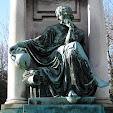I've always been a great admirer of Lynne Cohen's photographs of empty institutional spaces - sometimes of military complexes, sometimes of training facilities or classrooms or therapeutic establishments or factories - spaces that one passes through, transitional spaces, that have symbolic furnishings that are only occasionally used - like empty armchairs. Just occasionally, there's a stray dummy, or other form of human simulacrum. They are both made to look as though someone cares - at least sometimes - through the positioning of plants, or prints on the wall - but at the same time, they are profoundly sterile. They are places in which something, anything, has just happened, or is about to happen - but one can't quite tell what.
The reception desk at the National Humanities Center had just that quality when I was leaving this evening: akin to a set-up in an office catalogue, but at the same time with just a few hints that it's not utterly artificial (photographs of past classes of Fellows, for example). It's a space for people to populate with a story. Or as Cohen said in an interview for Canadian Art, “I once wrote about my work as being loaded with storytelling. Even if you know the work, it’s still always incredibly complicated. And why does it have to make sense? The images are pieces of a narrative puzzle that could be about anything. It’s totally absurd. Absurd, but it does tell a story. So the work goes back and forth; it is narrative and it isn’t.”
I went on line to hunt down this, or a similar, quotation from Cohen about the relationship that her photographs hold to narrative, and I was sadly disconcerted to find that she died back in May 2014. I don't know how I missed that: it makes all those silent empty spaces even more silent.



No comments:
Post a Comment